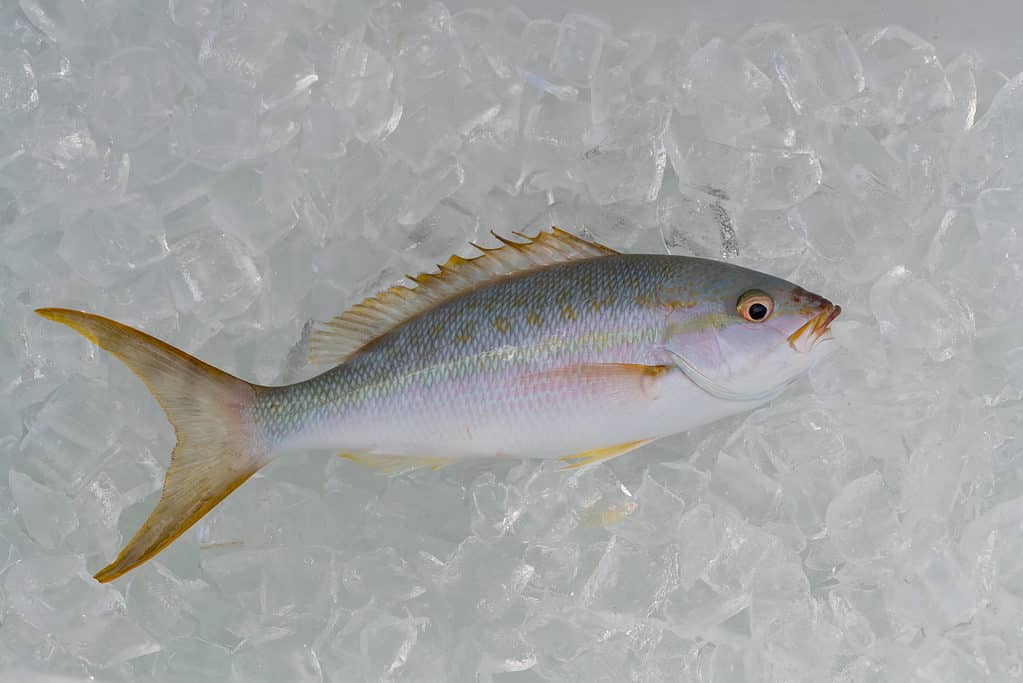Yellowtail Snapper
Ocyurus chrysurus
Yellowtail snapper can live up to 14 years!
Advertisement
Yellowtail Snapper Scientific Classification
- Kingdom
- Animalia
- Phylum
- Chordata
- Class
- Actinopterygii
- Order
- Perciformes
- Family
- Lutjanidae
- Genus
- Ocyurus
- Scientific Name
- Ocyurus chrysurus
Read our Complete Guide to Classification of Animals.
Yellowtail Snapper Conservation Status
Yellowtail Snapper Facts
- Prey
- zooplankton, shrimp, small fish
- Name Of Young
- fry
- Group Behavior
- School
- Fun Fact
- Yellowtail snapper can live up to 14 years!
- Biggest Threat
- Overfishing
- Most Distinctive Feature
- yellow stripe on body
- Diet
- Herbivore
- Lifestyle
- Nocturnal
- Slogan
- Fast moving ocean fish with a long yellow stripe.
View all of the Yellowtail Snapper images!
The yellowtail snapper is a beautiful fish with a striking yellow tail that is one of the most sought-after fish for human consumption.
Yellowtail Snapper Summary
As you can tell from its name, this fish is a member of the snapper family. It is a fish with a unique bright yellow tail native to the Western Atlantic Ocean. These fish are nocturnal carnivores that feed on animals such as shrimp, crabs, and smaller fish. They are an essential part of coral reef ecosystems as their feeding habits help to control the population of other fish species. Yellowtail snappers are also valuable fish species for recreational fishing and human consumption.
5 Incredible Yellowtail Snapper Facts
- Yellowtail snappers are considered to be a long-living species, with some fish living up to 14 years old.
- Yellowtail snappers are a popular game fish and are sought after by recreational anglers for their hard fighting and delicious meat.
- Yellowtail snappers can grow up to 30 inches long and weigh up to 10 pounds.
- Yellowtail snappers are commonly consumed and are most popular in Japanese and American cuisine.
- Yellowtail snappers are protogynous hermaphrodites, meaning they are born as females and can change sex to become males later in life.
Yellowtail Snapper Scientific Name
Ocyurus chrysurus
The yellowtail snapper is the only member in the genus Ocyurus, which is derived from the Greek words okys and oura meaning “swift” and “tail” respectively. Chrysurus is derived from the word chryso, which means “golden”.
Yellowtail Snapper Appearance
The yellowtail snapper has a distinct yellow lateral band that starts at the snout and gets wider towards the tail. The tail is completely yellow and is forked. The rest of the fish is a bluish and olive color with yellow spots above the yellow lateral band. The dorsal fin is yellow, and the anal and pelvic fins are white. The ventral aspect of the fish has a narrow longitudinal stripe that is almost pink.
This snapper is unique to other snappers in that they have a small head and mouth and do not have a dark spot below its dorsal fin. Although this fish can grow quite large, most do not grow larger than 16 inches – about the size of a large pizza!

A yellowtail snapper fish has a visible yellow lateral band from snout to tail.
©iStock.com/Kirk Hewlett
Yellowtail Snapper Evolution and History
The yellowtail snapper has evolved to have streamlined bodies that help with the animal’s speed. They are just one species of a large family of snappers, containing about 105 different species. It is a close cousin to the red snapper and mutton snapper, both of which have very different coloring and patterns. These fast fish have evolved to be great hunters, thanks to their teeth and aggressive nature.
Yellowtail Snapper Behavior
This type of fish lives in large groups or communities called schools. The fish hunt during the night, and they are known to be aggressive during this time of day. Yellowtail snappers are greedy, which means they will eat whatever is available. Older, more experienced yellowtail snappers tend to be more cautious than younger fish.
Yellowtail Snapper Habitat
These fish can be found in the western Atlantic Ocean all the way from Massachusetts and down south to Brazil, including Bermuda, the West Indies, the Gulf of Mexico, and the Caribbean. They are found in shallower waters around coral reefs where they thrive, but they can also be found in deeper waters up to 591 feet. Young yellowtail snappers live in inshore waters like estuaries and bays, where sea vegetation provides protection from their predators. Once the fish become established in a particular area, they tend to stay for long periods of time and rarely migrate far away. There is no place like home!
Yellowtail Snapper Diet
This fish is a nocturnal carnivore that eats a broad range of smaller oceanic animals. This can include everything from zooplankton to worms and even crabs.
What Eats the Yellowtail Snapper?
This fish has many predators. These predators are generally large fish such as mackerel, grouper, sharks, and even other larger snapper species.
What Does the Yellowtail Snapper Eat?
Their diet consists of small fish, worms, crabs, and shrimp. The juvenile snapper’s diet is plankton due to their small undeveloped mouths.
Yellowtail Snapper Predators and Threats
Besides sharks, mackerels, and other larger fish species, other animals that are predators of the yellowtail snapper include humans. Because this species of snapper is a popular game and food fish, it is a major victim of fishing.
Although there is a high demand for these fish, the yellowtail snapper is not overfished in the United States. In fact, in Florida, there are strict rules for fishing for snapper and a limit on the number of fish and the size of the fish caught to prevent overfishing. On the other hand, in Cuba and Brazil, the yellowtail snappers are overfished, and in Mexico, they are now considered highly vulnerable to overfishing.
Yellowtail Snapper Reproduction
Spawning occurs throughout the year and peaks in different months depending on the location, but an overall decline occurs in the wintertime. The eggs are released from the female into open water and hatch about 24 hours after they have been fertilized. The eggs contain a small droplet of oil, which provides enough buoyancy to keep them at the optimum depth in the ocean.
Yellowtail Snapper Babies
When the eggs hatch, yellowtail snapper babies are known as larvae. The larvae are sparsely pigmented and are around ⅜ inch long. The larvae will stick together for protection. These fish babies will only feed on plankton and other small invertebrates and worms until they have grown enough to eat larger animals.
As juveniles or fry, yellowtail snappers are grown enough to eat small animals such as fish and shrimp. At around 3 years of age and roughly 10 inches long, yellowtail snappers reach sexual maturity.
Yellowtail Snapper Lifespan
The life expectancy of this fish ranges from 6 to 12 years. These fish tend to have a slow growth rate. It’s worth noting that, as it is a highly prized game fish, many do not reach their maximum lifespan. The oldest recorded yellowtail snapper was 14 years old. Besides fishing, yellowtail snappers are prone to parasites that may affect their lifespan.
Yellowtail Snapper Population
The yellowtail snapper is an abundant species of snapper. Unfortunately, there is no information on the actual number of yellowtail snappers in the world. However, the conservation status of this fish is noted as “least concern”. So, there are no current threats to the population.
Yellowtail Snapper in Cooking
The yellowtail snapper is a popular fish to eat, especially in America and Japan. It is prized for its delicate, flaky meat with a mild flavor. The yellowtail snapper can be prepared in many ways.
One of the most popular ways to prepare yellowtail snapper in America is oven-baking the whole fish – either stuffed or marinated. In Japan, the yellowtail snapper is seared with a delicious teriyaki sauce on top.
Although delicious, there have been reports of poison in humans due to the consumption of the fish. This rare occurrence is known as ciguatera poisoning which happens when consuming a yellowtail snapper that has consumed a herbivorous fish that has eaten dead corals and macro-algae containing dinoflagellates.
Similar Animals
View all 32 animals that start with YYellowtail Snapper FAQs (Frequently Asked Questions)
Are yellowtail snappers carnivores, herbivores, or omnivores?
The yellowtail snapper is a carnivore, as the diet consists of animals such as shrimp, crabs, and small fish.
Do yellowtail snappers have teeth?
Yes, yellowtail snappers have small, fine teeth on the top jaw and larger teeth on the bottom jaw.
Is yellowtail snapper tasty?
Yes, yellowtail snappers are known to be one of the tastiest fish of the snapper family and are considered a delicacy in some countries!
How deep does a yellowtail snapper go?
The yellowtail snapper is generally found between 33 and 230 feet under the surface.
What is the average weight of a yellowtail snapper?
The average weight of a yellowtail snapper is around 3 pounds, but they can weigh up to 5 pounds.
Can you freeze yellowtail snapper?
Yes. Yellowtail snapper can be frozen for up to 3 months. It should be wrapped in plastic wrap or aluminum foil and placed in an airtight container before being placed in the freezer.
Thank you for reading! Have some feedback for us? Contact the AZ Animals editorial team.
Sources
- University of the West Indies/Ferina Riwana Ali, Available here: https://sta.uwi.edu/fst/lifesciences/sites/default/files/lifesciences/documents/ogatt/Ocyurus_chrysurus%20-%20Yellowtail%20Snapper.pdf
- Florida Museum/Cathleen Bester, Available here: https://www.floridamuseum.ufl.edu/discover-fish/species-profiles/lutjanus-chrysurus/
- National Library of Medicine, Available here: https://pubmed.ncbi.nlm.nih.gov/21967581/

















